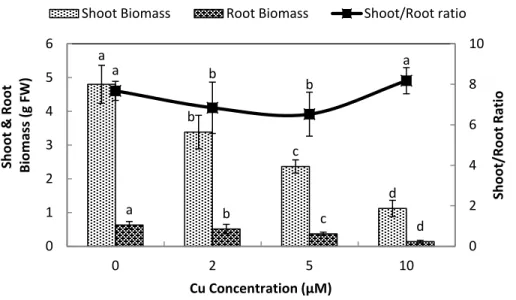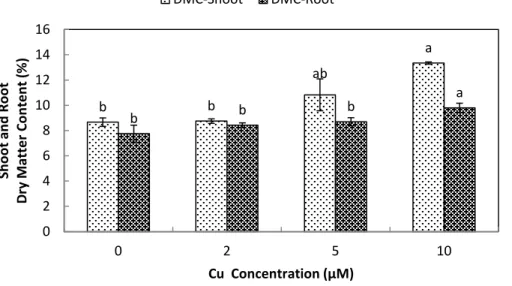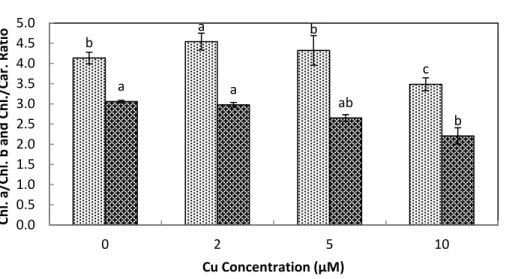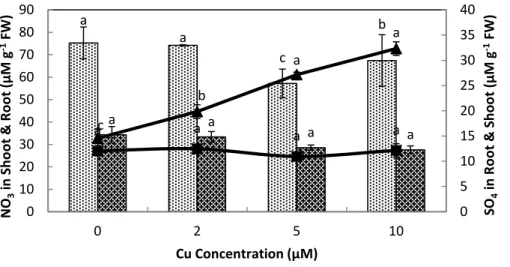Submitted 12 February 2015 Accepted 2 July 2015 Published4 August 2015
Corresponding author
Sajid Ali, sajid.iags@pu.edu.pk
Academic editor
Xiaolin Sun
Additional Information and Declarations can be found on page 8
DOI10.7717/peerj.1119
Copyright
2015 Ali et al.
Distributed under
Creative Commons CC-BY 4.0
OPEN ACCESS
Impact of copper toxicity on stone-head
cabbage (Brassica oleracea
var.
capitata)
in hydroponics
Sajid Ali1, Muhammad Shahbaz1,2, Ahmad Naeem Shahzad3,
Hafiz Azhar Ali Khan1, Moazzam Anees1, Muhammad Saleem Haider1 and Ammara Fatima4
1Institute of Agricultural Sciences, University of the Punjab, Lahore, Pakistan 2Department of Biology, Colorado State University, Fort Collins, Colorado, USA 3Department of Agronomy, Bahauddin Zakariya University, Multan, Pakistan
4Department of Environmental Science, Lahore College for Women University, Lahore, Pakistan
ABSTRACT
Arable soils are frequently subjected to contamination with copper as the consequence of imbalanced fertilization with manure and organic fertilizers and/or extensive use of copper-containing fungicides. In the present study, the
expo-sure of stone-head cabbage (Brassica oleracea var. capitata) to elevated Cu2+levels
resulted in leaf chlorosis and lesser biomass yield at≥2µM. Root nitrate content was
not statistically affected by Cu2+levels, although it was substantially decreased at
≥5µM Cu2+in the shoot. The decrease in nitrate contents can be related to lower
nitrate uptake rates because of growth inhibition by Cu-toxicity. Shoot sulfate
content increased strongly at≥2µM Cu2+indicating an increase in demand for
sulfur under Cu stress. Furthermore, at≥2µM concentration, concentration of
water-soluble non-protein thiol increased markedly in the roots and to a smaller
level in the shoot. When exposed to elevated concentrations of Cu2+the improved
sulfate and water-soluble non-protein thiols need further studies for the evalua-tion of their direct relaevalua-tion with the synthesis of metal-chelating compounds (i.e., phytochelatins).
Subjects Agricultural Science, Biochemistry, Plant Science, Soil Science, Toxicology
Keywords Leaf chlorosis, Nutrient uptake, Non-protein thiol, Cu contamination, Biomass, Sulfur,Brassica, Copper, Thiols, Hydroponics, Toxicity, Cabbage
INTRODUCTION
Transition metals such as copper (Cu), zinc (Zn) and molybdenum (Mo) are essential for
the growth and development of plants, but they rapidly get toxic at higher levels (Kopsell &
Kopsell, 2007). Cu contamination in agricultural soils as a consequence of mining metals, dispersal of sewage sludge, arbitrary and improper application of agrochemicals, addition of organic fertilizers and frequent use of irrigation with low quality water is a well-known
problem (Dach & Starmans, 2005;Yruela, 2009). Cu is a redox active metal that can exist in
both Cu2+and Cu+forms in living organisms. At the protein level, Cu serves as a co-factor
oxidase (Yruela, 2005;Yruela, 2009;Pilon et al., 2006). However, redox cycling between
Cu2+and Cu+could induce oxidative stress by producing highly toxic hydroxyl radicals
(Yruela, 2005;Yruela, 2009).
Plants exposed to elevated levels of Cu show unspecific toxicity symptoms. Elevated
Cu levels in soils primarily result in stunted root growth and leaf chlorosis (Kopsell &
Kopsell, 2007;Shahbaz et al., 2010a). Copper toxicity-induced reduction in chlorophyll contents hinder the development of chloroplast, thalakoid membrane and photosystem
II (PSII), which are considered as the most sensitive Cu toxicity sites (P¨atsikk¨a, Aroan &
Tyystj¨arvi, 1998;P¨atsikk¨a et al., 2002;Burkhead et al., 2009;Yruela, 2005;Yruela, 2009;
Shahbaz et al., 2010b). At cellular level, toxicity may lead to binding of sulfhydryl groups
in proteins, insufficiency or excess of other essential ions, oxidative damage and reduced
cell transport (De Vos et al., 1993;Yruela, 2009). Furthermore, Cu-toxicity can change
the mineral composition of plants. For instance, Fe contents may decrease in the shoot (P¨atsikk¨a, Aroan & Tyystj¨arvi, 1998;P¨atsikk¨a et al., 2002;Kopsell & Kopsell, 2007;Shahbaz et al., 2010b), Ca and Mg may decrease in the root and Zn contents may increase in both root
and shoot upon Cu exposure at elevated levels (Shahbaz et al., 2010b).
Root growth is more severely affected by elevated Cu than shoot growth and the major
proportion of Cu uptake retains in the root. Increased Cu contents in the plant tissues
induce the synthesis of metal-binding compounds (viz. phytochelatins), which are most
likely glutathione-derived compounds. (Inouhe, 2005;Ernst et al., 2008). Inductions of
phytochelatins presume that more sulfur is needed for synthesis of these compounds, which results into higher absorption, and incorporation of sulfate. Nonetheless, the role
of phytochelatins in detoxification of Cu is not very clear yet (Ernst et al., 2008;Yruela,
2005;Yruela, 2009;Shahbaz et al., 2010a).
Brassicaand other vegetable crops are often grown in the surrounding areas of big cities and industrial areas in developing countries like Pakistan, where they may be subjected
to air and heavy metals pollution (Yang, Stulen & De Kok, 2006). The direct application
of sewage water to vegetables is not only the source of many nutrients, but it is often contaminated with high levels of Cu and other heavy metals. As a result of continues untreated sewage application, heavy metals not only accumulate in the soil but also in
vegetables (Younas et al., 1998;Butt et al., 2005). High Cu content in crop plants might
not only negatively affect plant growth and functioning, but will also enter the food chain
(Brun et al., 2001).
MATERIAL AND METHODS
Stone-head cabbage (Brassica oleracea var. capitataF1) seeds were germinated to sand
in a green house. The seedlings collected at ten days after germination were transferred on an aerated 25% modified Hoagland nutrient solution in a 11 liter container
(15.8′′L×10.3′′W×7′′H; 3 plants set−1and 12 sets container−1) in a greenhouse for
10 days. The nutrient solution consists of 1.25 mM Ca(NO3)2.4H2O, 1.25 mM KNO3,
0.25 mM KH2PO4, 0/0.5 mM MgSO4.7H2O, 11.6µM H3BO3, 2.4µM MnCl2.4H2O,
0.24µM ZnSO4.7H2O, 0.08µM CuSO4.5H2O, 0.13µM Na2MoO4.2H2O and 22.5µM
Fe3+-EDTA with supplemental concentrations of 0, 2, 5 and 10µM CuCl2and pH 5.9–6.0.
The nutrient solution was continuously aerated with Aqua-Supreme—Air Pump—Model
AP-4.The photoperiod was 14 h. 30 and 25◦C (±5◦C) temperatures were set for day and
night respectively, whereas the relative humidity was maintained at 60–70%.
Pigment contents
Whole shoot was homogenized (in 100% acetone 10 mL per g FW) followed by
centrifugation at 800gfor 20 min.Lichtenthaler (1987)was followed for the determination
of chlorophylla,band total carotenoid contents.
Nitrate and sulfate contents
Frozen root and shoot material was homogenized in de-mineralized water (10 mL per g fresh weight) and one layer of Miracloth filter was used to filter the homogenate. The
supernatant was incubated in a water bath at 100◦C for 10 min. The remainder was
centrifuged for 15 min (0◦C) at 30,000 g. The anions were separated by HPLC andMaas et
al. (1986)was followed for their refractometric determination using a Knauer differential refractometer (model 98.00, Bad Homburg, Germany).
Water-soluble non-protein thiols
Extraction medium containing 80 mM sulfosalicylic acid, 1 mM EDTA, and 0.15% (w/v)
ascorbic acid with an Ultra Turrax at 0◦C (10 mL per g fresh weight) was used for the
homogenization of fresh plant matter. The resultant homogenous material was passed
through one layer of Miracloth which was then centrifuged at 30,000gfor 15 min (0◦C).
De Kok, Buwalda & Bosma (1988)was followed for the determination of total water-soluble
non-protein thiol content colorimetrically at 413 nm after reaction with 5, 5′-dithiobis
[2-nitrobenzoic acid].
RESULTS
Plant biomass in response to Cu exposure
Exposure of stone-head cabbage to higher concentrations of Cu2+(≥2µM) in nutrient
solution caused chlorosis of both the shoot and young emerging leaves, that ultimately reduced both root and shoot biomass production (Fig. 1). A 10 day exposure to increasing
Cu2+concentrations in nutrient media led to a significant reduction of both root and
a
b
c
d
a b
c
d
a b
b
a
0 2 4 6 8 10
0 1 2 3 4 5 6
0 2 5 10
S
h
o
o
t/
R
o
o
t
R
atio
S
h
o
o
t
&
R
o
o
t
B
io
m
ass (g FW
)
Cu Concentration (µM)
Shoot Biomass Root Biomass Shoot/Root ratio
Figure 1 Impact of elevated levels of Cu2+on biomass production of stone-head cabbage (Brassica
oleraceavar.capitata).10-day-old seedlings of stone-head cabbage (Brassica oleraceavar.capitata) were grown on a 25% Hoagland solution containing 0, 2, 5 and 10µM CuCl2in the root environment. Data on
biomass production (g FW) and shoot/root ratio represent the mean of 2 independent experiments with 9 measurements having 3 plants in each treatment (±SD). Means with different letters differ significantly atp≤0.01 (Student’st-test).
growth (Fig. 1). Root dry matter content increased at 10µM Cu2+, whereas shoot dry
matter content increased at≥5µM Cu2+(Fig. 2).
Pigment content in response to Cu exposure
The total chlorophyll (Chl.a+b) and carotenoid contents of stone-head cabbage were
significantly decreased upon exposure at≥2µM Cu2+(Fig. 3). There were significant
decreases in chlorophylla/band chlorophyll/carotenoid ratios when exposed to increased
Cu2+ concentrations (10µM Cu2+). TenµM Cu2+exposure resulted in the start of
rapid development of shoot chlorosis and significantly faster reduction in chlorophylla
contents of chlorophyllband carotenoids, ultimately leading to a significant reduction in
chlorophylla/band chlorophyll/carotenoid ratios (Fig. 3).
Sulfate and water-soluble non-protein thiol contents in response to Cu exposure
Elevated Cu2+levels showed a significant effect on concentration of the nitrate, sulfate
and water-soluble non-protein thiol in stone-head cabbage. The nitrate contents of the
roots showed a non significant response to the Cu exposure at different levels, however in
shoots it were significantly decreased at≥5µM Cu2+(Fig. 4). Sulfate contents in the roots
were not affected; however, Cu2+treatments of≥2µM substantially increased the sulfate
Further-b b
ab
a
b b b
a 0 2 4 6 8 10 12 14 16
0 2 5 10
S h o o t an d R o o t D ry M att e r C o n te n t (% )
Cu Concentration (µM)
DMC-Shoot DMC-Root
Figure 2 Impact of elevated levels of Cu2+on dry matter content of stone-head cabbage (Brassica
oleraceavar.capitata).10-day-old seedlings of stone-head cabbage (Brassica oleraceavar.capitata) were grown on a 25% Hoagland solution containing 0, 2, 5 and 10µM CuCl2in the root environment. Data on
dry matter content (%) represent the mean of 2 independent experiments with 9 measurements having 3 plants in each treatment (±SD). Means with different letters differ significantly atp≤0.01 (Student’s t-test). a b c d a b c d 0.0 0.1 0.2 0.3 0.4 0.5 0.6 0.7 0.8
0 2 5 10
Ch lo ro p h y ll (a+b) an d Car o te n o id s (m g g
-1 FW
)
Cu Concentration (µM)
Chl (a+b) Carotenoids
Figure 3 Impact of elevated levels of Cu2+on pigment content (chl. a+b & carotenoids) of stone-head
cabbage (Brassica oleracea var. capitata).10-day-old seedlings of stone-head cabbage (Brassica oleracea var.capitata) were grown on a 25% Hoagland solution containing 0, 2, 5 and 10µM CuCl2in the root
b
a b
c
a a
ab
b
0.0 0.5 1.0 1.5 2.0 2.5 3.0 3.5 4.0 4.5 5.0
0 2 5 10
Ch
l.
a/
Ch
l.
b
an
d
C
h
l./Car
. R
atio
Cu Concentration (µM)
chl. a/Chl. b Chl./Car.
Figure 4 Impact of elevated levels of Cu2+on pigment content (chl.a/chl.b & chl./car. ratio) of
stone-head cabbage (Brassica oleracea var. capitata).10-day-old seedlings of stone-head cabbage (Brassica oleraceavar.capitata) were grown on a 25% Hoagland solution containing 0, 2, 5 and 10µM CuCl2in
the root environment. Data on chlorophyll content (chl.a/chl.b and chl./carotenoid ratio) represent the mean of 2 independent experiments with 9 measurements having 3 plants in each treatment (±SD). Means with different letters differ significantly atp≤0.01 (Student’st-test).
more, the exposure to≥2µM Cu2+resulted in a solid raise in water-soluble non-protein
thiol contents in the roots and to a smaller degree in the shoots at 10µM Cu2+(Fig. 5).
DISCUSSION
Cu exposure at elevated levels (<2µM Cu2+) to stone-head cabbage significantly
decreased the production of root and shoot biomass and raised the ratio of the shoot to the root. Copper contamination in the root environment generally results in retarded production of root and shoot biomass and a reduced photosynthetic activity. Moreover,
it causes chlorosis, necrosis and bleaching of pigments (Yruela, 2005;Yruela, 2009;Sheldon
& Menzies, 2005;Shahbaz et al., 2010a;Shahbaz et al., 2010b). In cabbage, the reduced production of biomass when exposed to elevated Cu levels coincided with decreased
pigment contents (chl. a, b, carotenoids;Fig. 3) which may have resulted in reduced
activity of photosynthesis and the dark respiration rate (Shahbaz et al., 2010a). It has
been shown that Cu-toxicity damages chloroplasts either by inducing iron deficiency or
by replacing Mg in the chlorophyll by Cu (P¨atsikk¨a et al., 2002;K¨upper et al., 2003). Cu
exposure at elevated levels not only decreased the pigment content but there was also a change in pigment composition. Chlorophyll a content decreased significantly faster than that of chlorophyll b and carotenoids, which resulted in a decreased chlorophyll a/b and
chlorophyll/carotenoid ratio. Similar results were reported byChu et al. (2006)inTrifolium
repensL.
a
a
c
b
a a
a a
c
b
a
a
a a
a a
0 5 10 15 20 25 30 35 40 0 10 20 30 40 50 60 70 80 90
0 2 5 10
SO 4 i n R o o t & Sh o o t (µ M g
-1 FW
) NO 3 i n Sh o o t & R o o t (µ M g
-1 FW
)
Cu Concentration (µM)
Nitrate-Shoot Nitrate-Root Sulfate-Shoot Sulfate-Root
Figure 5 Impact of elevated levels of Cu2+on nitrate and sulfate content of stone-head cabbage
(Brassica oleraceavar.capitata). 10-day-old seedlings of stone-head cabbage (Brassica oleraceavar. capitata) were grown on a 25% Hoagland solution containing 0, 2, 5 and 10µM CuCl2 in the root
environment. Data on nitrate and sulfate content (µmol g−1FW) represent the mean of 2 independent experiments with 9 measurements having 3 plants in each treatment (±SD). Means with different letters
differ significantly atp≤0.01 (Student’st-test).
exposure to metal contamination could be due the fact that roots come in direct contact with toxic metals (Cd, Cu). Toxic metal-induced hindered root growth also reduces the
uptake of essential nutrients (Sheldon & Menzies, 2005).
Plants have evolved a tightly-controlled mechanism for the absorption, allocation and
assimilation of sulfate under normal conditions. (Hawkesford & De Kok, 2006). Enhanced
exposure of cabbage to Cu concentrations considerably affects the contents and allocation
of sulfur compounds in the root and shoot of cabbage (Shahbaz et al., 2010a). The raised
shoot sulfate contents might be attributed to Cu-toxicity induced upregulation of the
sulfate suppliers in roots (Shahbaz et al., 2010a). To maintain rapid growth rates under
stress conditions,Brassicaspecies increase their demand for sulfur supply (Koralewska
et al., 2008;Koralewska et al., 2009). Exposure of stone-head cabbage to elevated levels
of Cu did not affect the nitrate contents in roots, however at≥5µM Cu2+there was a
significant decrease in the shoot nitrate contents. The reduced production of plant biomass
at≥5µM Cu2+could be attributed to reduced supply of nitrate in the shoot. The decrease
in nitrate: sulfate ratio in the shoot of stone-head cabbage under elevated Cu levels may be attributed to enhanced sulfate contents, however the link between uptake rates of nitrate
and sulfate is not evident yet (Stulen & De Kok, 2012). Since both nitrate and sulfate are
involved in amino acid and protein synthesis, their uptake rates are related with growth
rates (Stulen & De Kok, 2012).
(Shahbaz et al., 2010a). Previous reports suggest that the formation of sulfur-rich metal-chelating compounds (i.e., water-soluble non-protein thiols) when disclosed to prospective toxic metals may perhaps require an enhanced demand for sulfur, viz. the
absorption rate and incorporation of sulfate (Sirko & Gotor, 2007;Ernst et al., 2008). The
possible significance of sulfur nutrition upon elevated copper exposure needs further investigation.
CONCLUSIONS
This investigation has shown that the elevated copper levels in the root surroundings
proved toxic for stone-head cabbage. Copper exposure at≥2µM Cu2+negatively affected
the plant biomass production and pigment contents. Furthermore, elevated Cu content
considerably affected the concentration of sulfate and water-soluble non-protein thiol of
stone-head cabbage which might be due to the induction of phytochelatins to detoxify excess copper.
ADDITIONAL INFORMATION AND DECLARATIONS
Funding
Funding was provided by the University of the Punjab, Lahore. The funders had no role in study design, data collection and analysis, decision to publish, or preparation of the manuscript.
Grant Disclosures
The following grant information was disclosed by the authors: University of the Punjab, Lahore.
Competing Interests
The authors declare there are no competing interests.
Author Contributions
• Sajid Ali conceived and designed the experiments, wrote the paper, prepared figures
and/or tables, reviewed drafts of the paper.
• Muhammad Shahbaz conceived and designed the experiments, performed the
experiments, wrote the paper.
• Ahmad Naeem Shahzad and Ammara Fatima analyzed the data.
• Hafiz Azhar Ali Khan contributed reagents/materials/analysis tools, wrote the paper,
prepared figures and/or tables, reviewed drafts of the paper.
• Moazzam Anees contributed reagents/materials/analysis tools.
• Muhammad Saleem Haider provided the facilities (laboratory and staff) for the research
work.
Supplemental Information
Supplemental information for this article can be found online athttp://dx.doi.org/
REFERENCES
Brun LA, Maillet J, Hinsiger P, P´epin N. 2001.Evaluation of copper availability to plants in copper-contaminated vineyard soils.Environmental Pollution111:293–302
DOI 10.1016/S0269-7491(00)00067-1.
Burkhead J, Reynolds KAG, Abdel-Ghany SE, Cohu CM, Pilon M. 2009.Copper homeostasis. New Phytologist182(4):799–816DOI 10.1111/j.1469-8137.2009.02846.x.
Butt MS, Sharif K, Bajwa BE, Aziz A. 2005.Hazardous effects of sewage on the environment: focus on heavy metals and chemical composition of soil and vegetables.Management of Environmental Quality16:338–346DOI 10.1108/14777830510601217.
Chu L, Liu DY, Wang YB, Ding JH, Wang LL. 2006.Separate and combined effects of Cu and Cd on seedling growth and active oxygen metabolism system ofTrifolium repensL.Frontiers in Bioscience11:2861–2867DOI 10.2741/2014.
Dach J, Starmans D. 2005. Heavy metals balance in Polish and Dutch agronomy: actual state and provisions for the future.Agriculture Ecosystems and Environment 107:309–316
DOI 10.1016/j.agee.2005.02.017.
De Kok LD, Buwalda F, Bosma W. 1988.Determination of cysteine and its accummulation in spinach leaf tissue upon exposure to excess sulfur.Journal of Plant Physiology133(4):502–505
DOI 10.1016/S0176-1617(88)80045-2.
De Vos CHR, Ten Bookum TM, Vooijs R, Schat H, De Kok LD. 1993.Effect of copper on fatty acid composition and peroxidation of lipids in roots of copper tolerant and sensitiveSilenecucubalus. Plant Physiology and Biochemistry31(2):151–158.
Ernst WHO, Krauss GJ, Verkleij GAC, Wesenberg D. 2008.Interaction of heavy metals with the sulphur metabolism in angiosperms from an ecological point of view.Plant Cell and Environment31(1):123–143.
FAO. 2013.FAOSTAT Domains.Available athttp://faostat3.fao.org/download/Q/QC/E.
Hawkesford MJ, De Kok LJ. 2006. Managing sulfur metabolism in plants.Plant Cell and Environment29(3):382–395DOI 10.1111/j.1365-3040.2005.01470.x.
Inouhe M. 2005. Phytochelatins.Brazilian Journal of Plant Physiology 17(1):65–78
DOI 10.1590/S1677-04202005000100006.
Kopsell DE, Kopsell DA. 2007.Copper. In: Barker AV, Pilbeam DJ, eds.Handbook of plant nutrition. Boca Raton: Taylor and Francis Group, 293–328.
Koralewska A, Buchner P, Stuiver CEE, Posthumus FS, Kopriva S, Hawkesford MJ, De Kok LJ. 2009.Expression and activity of sulfate transporters and APS reductase in curly kale in response to sulfate deprivation and re-supply.Journal of Plant Physiology166(2):168–179
DOI 10.1016/j.jplph.2008.03.005.
Koralewska A, Stuiver CEE, Posthumus FS, Kopriva S, Hawkesford MJ, De Kok LJ. 2008.
Regulation of sulfate uptake, expression of the sulfate transporters Sultr1;1 and Sultr1;2, and APS reductase in Chinese cabbage (Brassica pekinensis) as affected by atmospheric H2S nutrition and sulfate deprivation.Functional Plant Biology35(4):318–327DOI 10.1071/FP07283.
K¨upper H, ˇSetl´ık E, ˇSetlikov´a N, Ferimazova M, K¨upper FC. 2003.Copper-induced inhibition of photosynthesis: limiting steps ofin vivocopper chlorophyll formation inScenedesmus quadricauda.Functional Plant Biology30(12):1187–1196DOI 10.1071/FP03129.
Maas FM, Hoffmann I, Van Harmelen MJ, De Kok LJ. 1986.Refractometric determination of sulphate and other anions in plants separated by High-Performance Liquid Chromatography. Plant and Soil91(1):129–132DOI 10.1007/BF02181825.
P¨atsikk¨a E, Aroan EM, Tyystj¨arvi E. 1998.Increase in the quantum yield of photoinhibition con-tributes to copper toxicityin vivo.Plant Physiology117(2):619–627DOI 10.1104/pp.117.2.619.
P¨atsikk¨a E, Kairavuo MF, ˇSereˇsen EM, Tyystj¨arvi E. 2002.Excess copper predisposes photosystem II to photoinhibitionin vivoby outcompeting iron and causing decrease in leaf chlorophyll. Plant Physiology129(3):1359–1367DOI 10.1104/pp.004788.
Pilon M, Abdel-Ghany SE, Cohu CM, Gogolin KA, Ye H. 2006.Copper cofactor delivery in plant cells.Current Opinion in Plant Biology9:256–263DOI 10.1016/j.pbi.2006.03.007.
Shahbaz M, Tseng MH, Stuiver CEE, Koralewska A, Posthumus FS, Venema JH, Parmar S, Hawkesford MJ, De Kok LJ. 2010a.Copper exposure interferes with the regulation of the uptake, distribution and metabolism of sulfate in Chinese cabbage.Journal of Plant Physiology
167(6):438–446DOI 10.1016/j.jplph.2009.10.016.
Shahbaz M, Tseng MH, Stuiver CEE, Posthumus FS, Parmar S, Koralewska A, Hawkesford MJ, De Kok LJ. 2010b.Impact of copper exposure on physiological functioning of Chinese cabbage (Brassica pekinensis). In: Sequi P, Ferri D, Rea E, Montemurro AV, Fornado F, eds. 18th international symposium of CIEC. Fertilitas Agrorum, 318–324.
Sheldon A, Menzies NW. 2005.The effect of copper toxicity on growth and morphology of Rhodes grass (Chlorisgayana) in solution culture.Plant and Soil 278(1–2):341–349
DOI 10.1007/s11104-005-8815-3.
Sirko A, Gotor C. 2007.Molecular links between metals in the environment and plant sulfur metabolism. In: Hawkesford MJ, De Kok J, eds.Sulfur in plants—an ecological perspective. Springer, 169–195.
Stulen I, De Kok LJ. 2012.Exploring interactions between sulfate and nitrate uptake at a whole plant level. In: De Kok LJ, Tausz M, Hawkesford MJ, Hoefgen R, McManus MT, Norton RM, Rennenberg H, Saito K, Schnug E, Tabe L, eds.Sulfur metabolism in plants: mechanisms and application to food secuirity, and response to climate change. Dordrecht: Springer, 1–8.Available atwww.fao.org(http://faostat3.fao.org/download/Q/QC/E) (accessed 23 June 2015).
Yang L, Stulen I, De Kok LJ. 2006.Impact of sulfate nutrition on utilization of atmospheric SO2 as a sulfur source for Chinese cabbage.Journal of Plant Nutrition and Soil Science169:529–534
DOI 10.1002/jpln.200520574.
Younas M, Shahzad F, Afzal S, Khan MI, Ali K. 1998.Assessment of Cd, Ni, Cu and Pb pollution in Lahore, Pakistan.Environment International24:761–766
DOI 10.1016/S0160-4120(98)00068-3.
Yruela I. 2005. Copper in plants. Brazilian Journal of Plant Physiology 17(1):145–156
DOI 10.1590/S1677-04202005000100012.
Yruela I. 2009.Copper in plants: acquisition, transport and interactions.Functional Plant Biology



